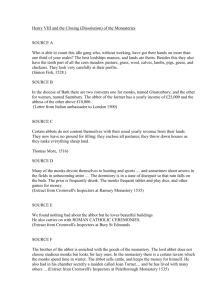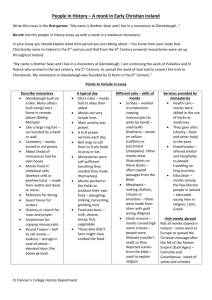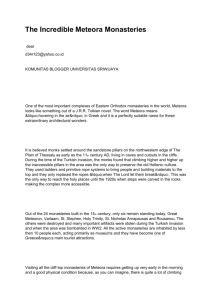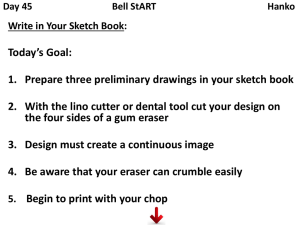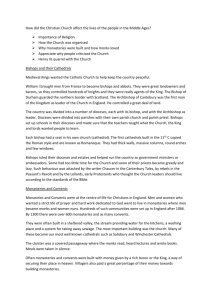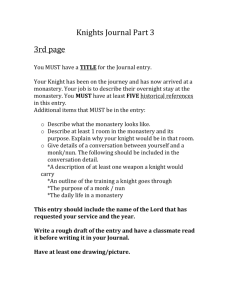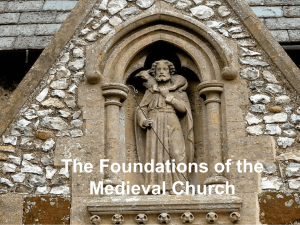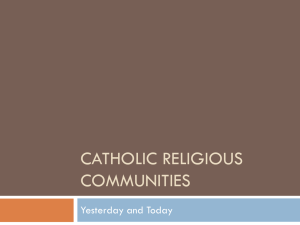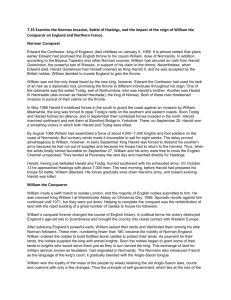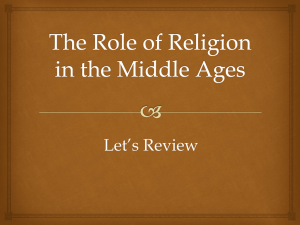Monasteries and ECI
advertisement
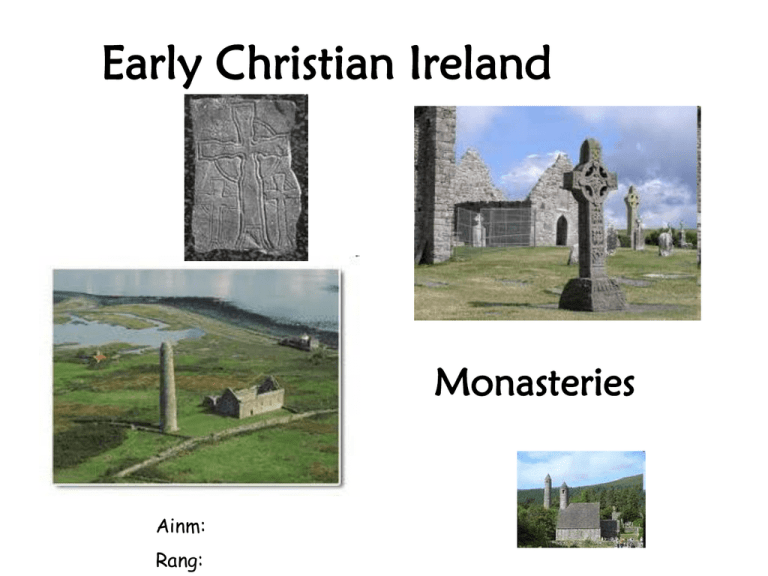
Early Christian Ireland Monasteries Ainm: Rang: What are Monasteries? •Monasteries were places where groups of men or women could live together and worship God. •The men were called monks and the women were called nuns. •A monastery is sometimes called an 'abbey' or a 'priory'. Monasteries for women are also sometimes called 'nunneries' or 'convents'. The Earliest Monasteries in Ireland were probably made from wood and therefore there is little evidence of their existance today. However written histories of the time and archaeological evidence has given us some indication of what life was like in these monasteries. The first Irish monks were hermits and lived in isolated places e.g. Sceilg Mhicil and Inishmurray The Skellig Islands, are 8 miles off the western coast of County Kerry. The are very isolated. They are also quite dangerous. The paths are very thin and narrow on the island. Some people have fallen off and died on these islands. Life was difficult on the island. They ate fish, sea-birds and whatever small crops they were able to grow on the thin soils. If the weather was good – some food and goods may have come from the mainland Task: Imagine you are a monk living on Sceilig Michil Write an account of your life… Beehive huts The monks on Sceilg Mhicil lived in beehive huts. The stones fit perfectly on top of each other. Their round shape also means that rain flows off the roof and walls. Look at the photo Why do you think the doors are really small? Irish monks and Missionary work Abroad Columcille (521-597 A.D.) was the Irish Monk who founded the monastery on the Island of Iona off Scotland where the Book of Kells was created, and converted the pagan Northern Picts (Northern Scots) to Christ. He lived about 60 years after St. Patrick. At the age of 44, Columcille left Ireland – there are many different stories told as to why Columcille left Ireland - and founded the monastery on Iona (563-5 A.D.). It was a base from which he would bring to Christianity the Northern Picts of Scotland. It became the place where the Scottish Kings received final interment. 100 years later Iona's ninth Abbot, Adomnan, would write a book called: Life of St. Columba. Early Christian Stone Crosses in Ireland Monks carved and decorated stone crosses at many monastic sites. Earliest examples were just stone slabs and later the stones have arms with a circle surrounding the arms The High Cross was virtually a sermon in stone, It is covered in carvings of stories and scenes from the bible. The circle is the main shape used on a high cross When high crosses were being made people could not read, in fact there really weren’t any books. Manuscripts took a long time to write and they were expensive to make, besides ordinary people couldn’t read them! So the pictures carved on the high crosses helped them to learn about God. They are like books or even the internet! Maybe Facebook 1. 2. 3. 5. 4. 1. Clonfert, Co. Offaly 2. Clonmacnoise, Co. Offaly 3. Faheen, Co. Kilkenny 4. Kells, Co. Meath 5. Monasterboice, Co Louth The Ardagh Chalice is made of silver and dates from around the 8th century. It has two handles, held. It is decorated with panels of gold filigree (these are tiny threads of gold shaped carefully into a design), There are red and blue glass studs on the chalice. All handmade! The Apostles names are lightly inscribed below the filigree band, with the exception of Judas. It was discovered in the 1860s by a boy digging for potatoes! It is now housed in the National Museum, Dublin. Task: Using your drama skills, divide into pairs – you are the boy who found the Ardagh Chalice how would you act it out? The Tara brooch is a circle of cast silver gilt covered with sheets of gold foil, and beautifully decorated with beads, twisted and plaited wires of gold, amber and glass studs, there are carvings of animals and spirals. Tara Brooch All of this in a piece less than 2inches in diameter! It dates from the 8th century approximately as does the Ardagh Chalice. The Tara Brooch is also kept in the National Museum. The Book of Kells Parts of pages from the book Manuscript pages were made from vellum or treated calf skins. 680 individual pages (340 folios) have survived, As many as ten different colours were used. Some of them rare and expensive dyes that had to be imported from the continent. The workmanship is so fine that some of the details can only be clearly seen with a magnifying glass. Some of the best preserved manuscripts of the 8th and 9th centuries are kept in the library of Trinity College in Dublin. Task: Do a survey of your classroom or household – what do they know about the Book of Kells? Did you know: The town of Kells wants the Book of Kells to return to the town! But Trinity College have said no!! What do you think about this? The Book of Durrow was written in about AD 675. It is one of the earliest manuscripts to have a carpet page, that is a page completely covered in pattern and colour. It disappeared from the Abbey in the 16th century but luckily was found again! A farmer was using it to pour water on it to cure his cattle! Task: write a newspaper article about the discovery of the Book of Durrow! These are two designs of interlocking animals from the book of Kells. It took the monks a long time to create these designs and make sure that they looked perfect. It took years to train a monk before he could work on real manuscritps Draw your own High Cross here. Tell a story of your choice 4. 3. 2. 1. St. Enda, Aran Islands, Co. Galway St. Patrick, Armagh, Co. Armagh St. Brigid, Kildare, Co. Kildare St. Ciarán, Clonmacnoise, Co. Offaly St. Kevin, Glendalough Co Wicklow Can you find these monastery locations in your atlas and put them onto this map? Mark the number 5.


